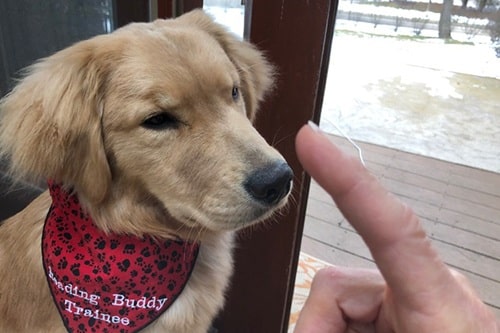Dogs have many natural instincts that they have a hard time suppressing on their own. However, with the right amount of quality training, you will find that your dog can ably adapt to a new normal.
The first thing to teach your good boy or girl is patience because everything else follows on from there. Through patience, they interact with others safely and behave themselves when near tempting foods or on adventurous walks.
Here at K9 Reading Buddies of the North Shore, we strive to ensure that all our dogs are tolerant and social when helping kids to read. Patience is the foundational level of other positive behaviors later down the line. Therefore, when you are training your pooch, patience is one of the first things for them to master.
Below, we have supplied you with a few tips to help you make this process easier. Without further ado, here is how to effectively teach your dog patience.
Make Them Sit And Be Pampered
Instead of asking what your dog can do for you, instead of asking yourself what you can do for them!
Dogs are forever cleaning themselves, frequently licking and biting different parts of their bodies to be hygienic. However, they also do this if something is bothering them, like stinky odors and matted fur. You cannot blame them for this, as when most people have a bothersome itch, a fuss is most certainly kicked up!
Therefore, you can help things along by teaching them patience by only grooming them well. This will mean fewer distractions that will get in the way of your efforts, and you will also just be helping to instill a sense of natural calm within their soul. When they are feeling great day-to-day, teaching them patience will be a far easier process. Soothingly stroke their fur with a brush, and you will put them at ease before the trimming.
He or she will also have to keep still while the grooming is going on. This way, you can keep them nice and tidy and train them to be still at the same time. If they have remained patient and behaved well during this period, offer up a treat. Once you get in that routine once a week or fortnight, overtime patience will come more easily.
Manage Treat Distribution
Treats are either a handy training tool or a greedy obsession for your best friend.
Take your dog for a walk and practice the ‘wait’ command. Find an open area, instruct your dog to sit, and hold a treat aloft to your face so that he or she can see it. Slowly walk backward while repeating the ‘wait’ and ‘sit’ commands, and after a distance of a few feet, call them over and give them the treat. Gradually increase the parted distance with each new effort, and eventually, your dog will understand what is expected of them.
It is best to dish out treats as an incentive for training purposes rather than to treat your dog alone occasionally. By keeping a firm lid on how many treats you give to your pup, you will be swerving around all their pining for a snack every time you rustle a packet of chips. Please give them a tasty something on occasion, but principally use the treats as a useful training tool.
Socialize Them
Dogs frequently get overly excited or distressed at the sight and smell of others during their walk.
Therefore, it is a good idea to try and socialize them. Take your dog to community playdates for pups or introduce them to your friends and their dogs. The more they interact with others, the more ably and calmly they will deal with others.
Here at K9 Reading Buddies of the North Shore, our dogs are regularly interacting with kids and adults both in-person and over video conferencing calls, on occasion, too! Dogs mostly fear what they do not know. Consequently, people’s voices and just being around others helps them acclimatize to the behaviors that you expect of them.
Share the Responsibility
If you’re living in a home with multiple occupants, then your dog needs to be answerable to them all.
We’ve mentioned before the perks of everyone taking on different roles in training a puppy well. The positive reinforcement needs to come from multiple parties because it is the best way to set a household-wide standard of behavior. If your dog has assigned an ‘alpha’ and is only answerable to one person… well, what happens when that person is out at the store? What if another member of the family ‘goes easy on them?
Therefore, a regimented training plan where everyone has a role is critical. It fires up the pack mentality in your pup to want to fit in with the established order. There are blanket rules in homes, and when everyone enforces them, your pup will quickly get in line.
Moreover, there is something to be said for practicing your patience too. If you are visibly irritated or frustrated with the training or with anything else, your dog will pick up on that and mirror your behaviors. No matter how old or what breed your pooch is, they are readers of emotion, and they do acclimatize to social environments, so it is vital that you all set a good example.
Put Their Skills To Good Use
The final phase of teaching your dog is to apply their newfound skills to real-world situations.
What is learned can also be unlearnt, so your dog must get to put their patience into practice in real-world situations. For example, you can make them sit and wait before crossing roads, making their patience part of the daily routine. This will teach them some semblance of control and discretion and let you ultimately navigate the direction and pace of your walk.
If you are confident in their abilities, you could consider making your pup a part of our program, where their refined senses of calm can be put into constant use for prolonged periods. Dogs can be brilliant, but they cannot necessarily recall lessons of days gone by the way people can. By instilling patience as part of their daily routine, you stand a far better chance of the training ultimately being successful.



